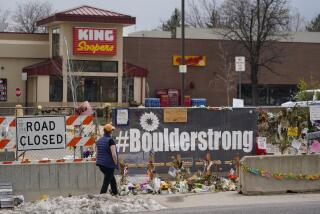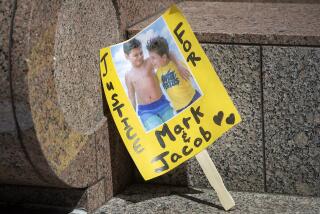Suspect in Motor Rampage on Trial
- Share via
SANTA BARBARA — Comparing a shattered mirror to his client’s fractured mind, the attorney for accused motor rampage killer David Attias said the teenager could not have grasped what he was doing the night he ran down five people on a crowded Isla Vista street.
In opening statements Monday in the murder trial of the former UC Santa Barbara freshman, defense lawyer Jack Earley said Attias suffered from apocalyptic visions, believed he had a special gift to see evil in others, and rambled incoherently as his mental disease overtook him.
“He became delusional,” said Earley, addressing the seven-man, five-woman jury. “He talked about good and evil. He thought it was his job to spread good.”
How that translated into one of the more devastating campus tragedies to strike a California college in years will be explained, Earley said, by a procession of therapists and counselors who treated Attias before and after the incident that claimed four lives in the largely student community adjacent to UC Santa Barbara.
Earley addressed the jury after an opening statement by Santa Barbara Assistant Dist. Atty. Patrick McKinley, who posted still photos of the gruesome accident scene as the trial got underway.
Because Attias has pleaded not guilty by reason of insanity, the central issue is not whether he was at the wheel the night of Feb. 23, 2001, but whether he should be held criminally responsible. He faces four counts of murder, as well as four counts of gross vehicular manslaughter while intoxicated.
Earley’s contention was that Attias had no concept of what he was doing when he ran a stop sign and plowed into a mixed group of students and visitors walking along the street.
As Earley spoke, the defendant showed little emotion, but drank frequently from a cup of water. Attias was dressed in a gray sweater that, along with his ruddy cheeks and baby-faced features, made him look even younger than his 19 years.
The accident’s only survivor, Albert Levy, was also in court along with some of his friends. Levy had been visiting his sister, Ruth, with friend Elie Israel that night. Israel and Ruth Levy, along with Nicholas Bourdakis and Christopher Divis, both 20, were killed.
According to Earley, the then-18-year-old freshman’s world was slowly coming undone in the weeks leading up to the tragedy. Diagnosed as having a bipolar disorder, he had stopped taking medication, grown angry at his father--Hollywood producer Daniel Attias--and become more and more obsessed with what he saw as the catastrophic consequences of his continuing virginity.
The still photos that the jury saw Monday were taken from a videotape of the incident made by amateur filmmakers who happened by just after the accident. The tape, which will be shown later, reportedly shows Attias running around in the street, shouting “Ride or Die,” and calling himself the “angel of death.”
While it’s become increasingly clear since the accident that Attias was deeply disturbed, Earley tried to lay out for the jury the full extent of it. As Attias’ mind fell apart, according to Earley, he began to believe that the musicians he admired were prophets and that their lyrics were keys to unlock the mysteries of life and death.
Earley said the young man was so troubled by a long history of psychological problems that he should not be thrown in prison but placed in a mental institution “where he can get treatment.”
Earley said that, given Attias’ mental problems, the only reason his client is facing a murder charge is because four people died.
“The major issue,” he said, “is that there is no evidence he intended to do this.”
Some witnesses, however, have said Attias’ 1991 Saab was accelerating when it hit the pedestrians.
The trial before Superior Court Judge Thomas Adams is expected to last eight weeks.
More to Read
Sign up for Essential California
The most important California stories and recommendations in your inbox every morning.
You may occasionally receive promotional content from the Los Angeles Times.













